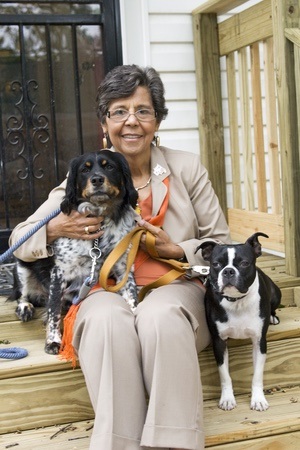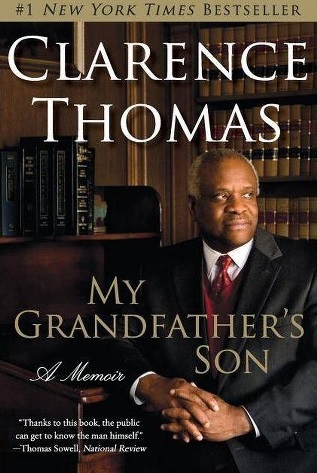Clarence Thomas — The Man We Love To Hate! By C. Ellen Connally

CoolCleveland.com, By C. Ellen Connally, Posted April 14th 2022
In the history of the United States Supreme Court there has only been one associate justice impeached. That distinction goes to Samuel Chase who served from 1796-1811. Samuel Chase is not to be confused with Ohio’s Salmon P. Chase, an anti-slavery lawyer from Cincinnati who served in the 19th century as Ohio governor, United States senator, Secretary of the Treasury and Chief Justice of the United States.
A native of Maryland, Samuel Chase was a signer of the Declaration of Independence, served in the Revolutionary War Congress and was a noted judge on the Maryland bench before going to the Supreme Court. Unfortunately, his judicial wisdom has been overlooked by his impeachment.
After making some remarks that his opponents found too political for a Supreme Court Justice, Chase was impeached in 1805 and tried before the Senate. Attempts to remove him fell flat when there were insufficient votes to find him guilty of any wrongdoing. Historians point to the failure to remove Chase as a victory for judicial independence. But the other side of the coin points to the dangers of a Supreme Court Justice articulating political philosophies, particularly those at odds with the prevailing sentiment of the nation.
Which brings me to the subject of the justice that I love to hate — Supreme Court Justice Clarence Thomas. My dislike and abhorrence for Thomas has caused me — an inveterate book buyer and student of American history — to read and fill part of a shelf in my library with books about Thomas. I managed to hold my nose with a barf bag at hand while I read his syrupy and self-serving autobiography entitled My Grandfather’s Son (Harper Collins Publishers, 2007) where he tells his rags-to-riches story of going from poverty in Pin Point, Georgia to the Supreme Court of the United States. As I recall, I skipped the last few pages — it was just too unctuous.
In 1994, investigative reporters Jane Mayer and Jill Abramson published my favorite book on Thomas. Entitled Strange Justice — The Selling of Clarence Thomas (Houghton Mifflin Co., 1994), the two authors dig deep into Thomas’ past, revealing interesting tidbits putting him in anything but a favorable light. They make the case that Anita Hill never lied.
I particularly liked the incident they describe during the time of Thomas’ confirmation hearings. They showed his photo to the operator of a video shop located near Thomas’ home that specialized in pornography. When asked if he recognized the photo, the clerk readily replied, “Oh, that guy, yeah, he comes in all the time.” Of course, the sanctimonious Thomas denied any knowledge of ever visiting such a place of ill repute and accused the senators of engaging in “a high-tech lynching for uppity blacks.”
Just the names of the books that have been written about Thomas reveal a lot about him. There’s the 2007 book Supreme Discomfort — The Divided Soul of Clarence Thomas by Kevin Merida and Michael A. Fletcher (Doubleday, 2007); Corey Robin’s 2019 The Enigma of Clarence Thomas (Metropolitan Books, 2019) and Silent Justice — The Clarence Thomas Story by John Greenya (Barricade Press, 2001), so named because his silence on the bench as been deafening for years.
According to several accounts, Thomas first met his current wife, Virginia Bess Lamb, when they were on a panel at an Anti-Defamation League conference in New York in 1986. She was a labor relations attorney and spokeswoman for the Chamber of Commerce and the daughter of a well-connected Republican family from Omaha, Nebraska. He at the time was head of the Equal Employment Opportunity Commission.

After the panel discussion, the two ended up sharing a cab to the airport. From that chance meeting, they struck up a friendship. She volunteered to fix up the then-divorced Thomas with some of the Black women that worked in her office. He declined. Instead, Thomas and Lamb went on a movie date — I doubt if they saw Guess Who’s Coming to Dinner — followed by a walk around Baltimore’s Inner Harbor. Less than a year later, they were married in a largely white Methodist Church in Omaha.
The irony of the relationship is that according to Thomas’ classmates at Holy Cross and Yale Law School and related in several accounts of his life, he had always expressed distaste for interracial dating and marriage. Back then, according to biographers Merida and Fletcher, “… his prototypes of a fine woman were Angela Davis and Kathleen Cleaver, two black militants with big Afros.”
Starting on page 180 of his autobiography, where he describes his meeting with Lamb, Thomas laces virtually every event in his life with “Virginia and I.” He goes on ad nauseum to describe how his life changed after marrying her and how he never felt like a complete person until they got together. He fails to mention that at the time of their marriage, his finances were not great. He was still paying off student loans and supporting his son from his previous marriage. Her income and inheritance greatly enhanced the family purse strings.
Fast forward to the events of January 6, 2021. Early on, rumors circulated that Virginia Thomas financed buses to bring demonstrators or rioters, depending on your perspective, to Washington. While those rumors proved to be untrue, the New York Times has now revealed that Mrs. Thomas sent 29 text messages to President Trump’s chief of staff Mark Meadows urging that the election be overturned. The text also reveal that she was in contact with Trump son-in-law Jared Kushner and Trump advisor Sidney Powell, all arguing that Trump had been reelected. At the same time, Trump was pressing for the Supreme Court to be the final arbiter of the election.
Thomas, who has always been one of Trump’s most stalwart defenders on the court, was the lone dissenter in February 2021, when the court declined to hear a case filed by Pennsylvania Republicans that sought to disqualify certain mail-in ballots. In January of this year, he was the only justice who voted against allowing the release of records from the Trump White House related to the January 6, 2021, attack.
The woman that Clarence Thomas shares a bed with is about as far right and pro-Trump as you can get and still be on the political spectrum. Her appearances over the last several years at partisan political conferences, often with Thomas in tow, have raised the questions about Thomas and his ability to make fair and impartial decisions. The January 21, 2022, issue of the New Yorker magazine raised the provocative question in a lengthy feature article: “ Is Ginni Thomas a Threat to the United States Supreme Court?” The article makes the case that the woman born Virginia Lamb is the wolf in sheep’s clothing lingering at the door of the Supreme Court.
Winston Churchill once described Russia as a riddle wrapped in a mystery inside an enigma. That’s analogous to Clarence Thomas. But maybe more like an Oreo cookie trying to prove to the world that he’s a vanilla wafer.








